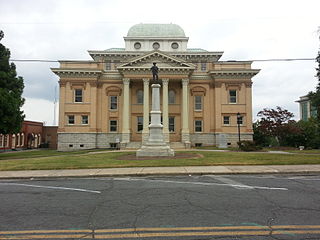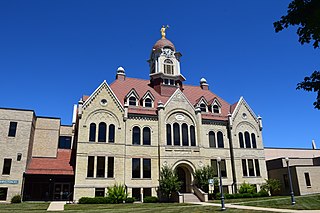
Rockingham County is a county located in the U.S. state of North Carolina. As of the 2020 census, the population was 91,096. Its county seat is Wentworth. The county is known as "North Carolina's North Star".

Wentworth is a town in Rockingham County, North Carolina, United States. The population was 2,646 at the 2020 census. Wentworth is the county seat of Rockingham County and is part of the Greensboro-High Point metropolitan area of the Piedmont Triad. On May 6, 2022, an EF-1 Tornado hit Wentworth. The storm traveled as a supercell with crazy structure from the Pilot Mountain, North Carolina, and Pinnacle, North Carolina, area across central Stokes County and into Rockingham County. It took out trees, damaged homes, and blocked roads before it lifted off southwest of Reidsville.

The Dubuque County Courthouse is located on Central Avenue, between 7th and 8th Streets, in Dubuque, Iowa, United States. The current structure was built from 1891 to 1893 to replace an earlier building. These are believed to be the only two structures to house the county courts and administrative offices.

The Allen County Courthouse is an historic courthouse building located at the corner of North Main Street & East North Street in Lima, Ohio, United States. In 1974, it was added to the National Register of Historic Places.

Ashtabula County Courthouse Group is a registered historic district in Jefferson, Ohio, listed in the National Register in 1975.

Jackson County Courthouse is an historic courthouse located at Sylva, serving Jackson County, North Carolina. It was designed by Smith & Carrier and built in 1913, when Sylva took over the county seat designation from Webster.

The Carroll County Courthouse is located in Carrollton, Ohio, and is the second for the county. It was designed by architect Frank Weary in the Second Empire style. The courthouse was placed on the National Register of Historic Places on 1974-10-22.

The Cuyahoga County Courthouse stretches along Lakeside Avenue at the north end of the Cleveland Mall in downtown Cleveland, Ohio. The building was listed on the National Register along with the mall district in 1975. Other notable buildings of the Group Plan are the Howard M. Metzenbaum U.S. Courthouse designed by Arnold Brunner, the Cleveland Public Library, the Board of Education Building, Cleveland City Hall, and Public Auditorium.

The Wilkes County Courthouse is a historic government building and clock tower located in the city of Washington, Georgia, the seat of Wilkes County. The latest in a series of courthouses in the county's history, the current building was completed in 1904 and since that date has been the official home of Wilkes County's Superior Court, and the base of the county's government. On September 18, 1980, the building was added to the National Register of Historic Places.

The Warsaw Courthouse Square Historic District is a historic district in Warsaw, Indiana that was listed on the National Register of Historic Places in 1982. Its boundaries were increased in 1993.
The old Oconee County Jail was a former jail located on Short Street in Walhalla, South Carolina, in Oconee County. The jail was located on the grounds of the current Oconee County Courthouse. It was named to the National Register of Historic Places on November 14, 1982, along with the Oconee County Cage. At the time of its listing, the jail was one of the few remaining nineteenth or twentieth century jails in upper northwestern South Carolina. It was demolished around 1985. Subsequently, it was delisted on December 12, 1989.

Clinton County Courthouse is located in Clinton, Iowa, United States. It was built in 1897 and added to the National Register of Historic Places July 2, 1981, as a part of the County Courthouses in Iowa Thematic Resource. It is the fourth courthouse that has been used by the county.

The Henderson County Courthouse, also known as the Historic Henderson County Courthouse and the Old Henderson County Courthouse, is a historic 3-story brick gold-domed Classical Revival style courthouse building located at One Historic Courthouse Square, corner of 1st and Main streets in Hendersonville, North Carolina.

The Des Moines County Court House located in Burlington, Iowa, United States, was built in 1940. It was listed on the National Register of Historic Places in 2003 as a part of the PWA-Era County Courthouses of Iowa Multiple Properties Submission. The courthouse is the fourth structure to house court functions and county administration.

The Scott County Courthouse in Davenport, Iowa, United States was built from 1955 to 1956 and extensively renovated over a ten-year period between 1998 and 2009. It is the third building the county has used for court functions and county administration. It is part of a larger county complex that includes the county jail, administration building and juvenile detention facility. In 2020 the courthouse was included as a contributing property in the Davenport Downtown Commercial Historic District on the National Register of Historic Places.

The Randolph County Courthouse is a historic courthouse located at Asheboro, Randolph County, North Carolina. It was designed by Wheeler, Runge & Dickey and built in 1908–1909. It is a three-story, Classical Revival-style yellow brick building with a hipped roof. It features a powerful Second Empire dome clad in ribbed tile and front portico. The listing included three contributing buildings on 3.1 acres (1.3 ha). The two other contributing buildings are an early-20th century jail and late Victorian brick building containing law offices.

The Clay County Courthouse is located on Main Street in Hayesville, Clay County, North Carolina. The T-shaped two-story brick building was built in 1888, and is a prominent local example of vernacular Italianate architecture. Its most visible feature is a three-story square tower, which projects for half its width from the main facade, and through which entry to the building is gained.

The Dickinson County Courthouse is located in Spirit Lake, Iowa, United States. Built in two phases in 2006 and 2009, it is the fourth building to house court functions and county administration.

The Oconto County Courthouse is a county courthouse in Oconto, Wisconsin, United States. It houses the circuit court and government offices of Oconto County, Wisconsin. The courthouse was built in 1891, with major alterations in 1907 and 1963. It was listed on the National Register of Historic Places in 1982 and the state register of historic places in 1989 for its local architectural significance.























